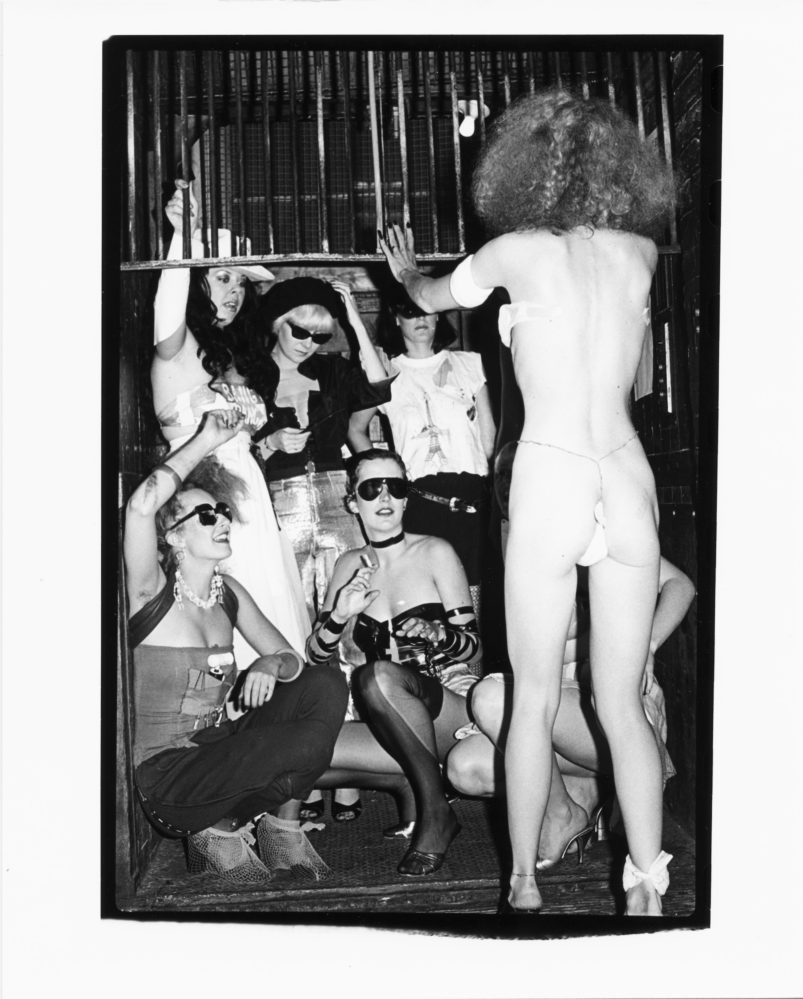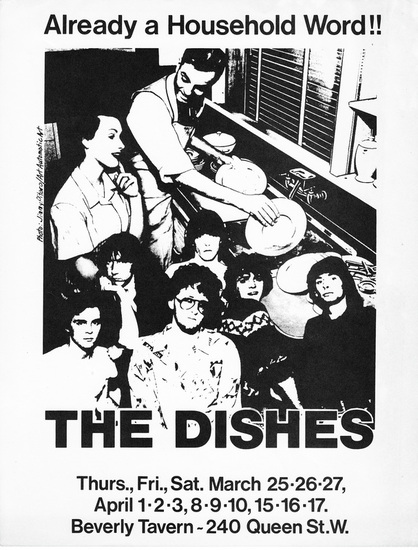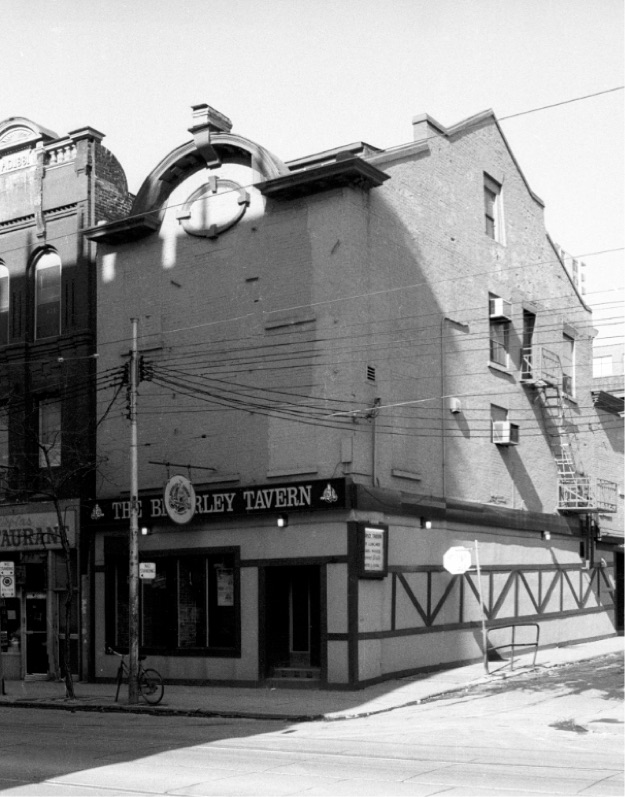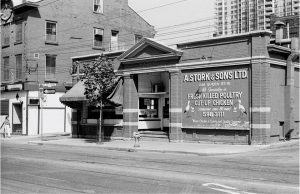[This is the fourth section of the blog post “how the Queen Street West scene began, pt. 2: OCA bands”]
On September 24, 1976, the Ramones played Toronto for the first time and blew people’s minds. Seven months previously, the Dishes secured a residency at the Beverley Tavern, which till that point had only haphazardly booked live music.
At nine o’clock a horrible country and western band would come on. I just realized, Wait a minute, we could start putting on shows here. So I approached the manager and the Dishes started playing there in early 1976. [Steven Davey, quoted in Worth 2011: 36]
The Ramones concert and the Dishes residency are equally important to the full-blown emergence of the punk and new wave music scene on Queen Street West, the former as proverbial inspiration, the latter as oft-forgotten precondition. In my last post I introduced the Dishes as a band whose suburban origins fit the pattern typical of the Thornhill sound. (The band’s 2002 anthology CD reserves final thanks to “the long-suffering Farr family and Buttons the Boston terrier for the use of the rec room.”) Here I focus on how they went further than any other Thornhill band before them to lay the foundation for Toronto’s 1970s-80s music scene.
What QSW was like then
I’ve previously made note of the generally industrial character and largely immigrant population of the Queen Street West neighborhood that lay just south of the OCA. To get a better sense of the streets on which first art spaces and later music venues began to thrive in the second half of the 1970s, people who were there recall what they remember.
The street was really bad to drive on because of the streetcars; it was all broken up, so most people who drove downtown would avoid it. [John Hamilton, quoted in Worth 2011: 34]
At the time Queen Street West, where the Beverley Tavern was, there was a chicken processing factory next door which added to the ambiance of the place. People would be chopping the heads off chickens with the door open. [Ken Farr, quoted in Worth 2011: 37]
Places like The Rex and the Bev were mostly habituated by older local gentlemen who’d smoke and drink the quart sized bottles of beer you could only get in bars. The neighborhood was decidedly working class at best in the 70s. There is a large public housing project situated directly north of Queen and west of Spadina. The Fred Victor Mission and The Salvation Army are also in the neighborhood. For good reason! [Scott Davey]
I don’t remember, when I was first living there, it feeling hip. I just remember it feeling very student… When I was a student, I was unaware of people having studios [around QSW]. I lived in a rooming house, and my studio was my bedroom/studio. [Barbara Astman]
And you know, the great thing about that new wave era in the late 1970s in Toronto is that vintage — all the clothes were available new, you know? They were old stock. You know, the vintage stores had bought out old stock from other stores. So you could get great clothes, cheaply. [Philip Monk]
I’d go on Queen Street and it was all greasy spoons, and the bookstore — the Peter Pan Bookstore, right next to where the Peter Pan Restaurant still is today. The Peter Pan Bookstore is one of those places where MacLeod and I went in 1968 to get Howl and On the Road and The Soft Machine and books like that, that we liked to read. [Owen Burgess]
On Queen Street at the same time, there was a big electronics store opened up called Arkon Electronics… And then there was Active Surplus, and then there was a computer store as well. So three places opened up on Queen West serving this sort of hobbyist/emerging computing thing at the same time as the Queen West restaurants were opening and the clubs were just sort of beginning — speakeasies, places to play, new, you know, art collectives. Just all kind of started the same year, it seems… But still mostly, you know, furniture and appliance stores, you know, this kind of thing. Hungarian restaurants, bacon and egg places. [Ian Mackay]
The Bev
The Dishes can take considerable credit for launching the QSW music scene because they convinced the proprietors of the Beverley Tavern to take a chance on genuine up-and-coming bands. Live music would happen upstairs, while downstairs the “rubby” bar (I learned a vivid new adjective in the course of this research) would serve the Bev’s regulars.
We had to start the Beverley. To play in this city anyway you had to be in the Musicians’ Union to play, or so they told you, and you had to be represented by an agent if you wanted to play one of the eight clubs in town that put bands on. It was closed to us; there was nowhere to play. So when we saw Rough Trade at Grossman’s, and then they started playing Tuesday nights in a discotheque when things were normally closed, and then coupled with everything that was happening in New York, it made us say, “Well, we’ve got this place with cheap beer, and art students are a block away.”
John Hamilton’s first band [the Daily Planet] played at the Beverley before the Dishes did, but they were terrible. They played in front of an empty audience. They were sort of a half-bar band, like they played all covers and then they did a couple of their own songs. But they were long-haired and there was nothing new about them. But they did play there before the Dishes. [Steven Davey, quoted in Worth 2011: 37]You know, my father used to go to the Beverley, so it was always there. When I used to come home he’d go, “Where did you stay out till two in the morning?” Because Toronto closes at eight o’clock at night, right? And I said, “There’s this place on Queen Street called the Beverley Tavern.” He goes, “Upstairs?” And I thought, Well, he doesn’t hang out with the Dishes or anything. But he used to go there after work years earlier. [music writer Gary Pig Gold, quoted in Worth 2011: 37]
The Dishes made an extraordinary splash among students, hipsters, artists, and young denizens for their clever, outré glam music and presentation, as well as their confident amateurism. By the time the Ramones concert in September 1976 lit the fuse for Toronto’s punk explosion, many QSW scenesters had already received the message that they too could form a band and, with some luck, get a gig at the Beverley.
The Dishes became wildly popular. They were huge. I loved going to see those guys. I really did. I mean, I mixed sound for them a few times and stuff, but really, the band was just great. It was really, really good. They played well put-together sarcastic humorous stuff. I mean, any band that does a song about Richard Speck, the guy who mass murdered nurses and things like that — that doesn’t sound so good coming out of my mouth now. Back in the day we thought it was really funny. [John Corbett]
We played an entire evening to just John Corbett once! I asked him how he liked the show – he said it was great and we sounded exactly like we sounded in the rehearsal basement. So the entire audience was pleased that night. [Tony Malone]
In turn “the Bev” demonstrated an audience for bands without reputations, managers, or union cards — the typical requirements of cover bands and A-listers to that point in Toronto nightlife. It welcomed similar new wave groups and, by the following year, more bracing punk groups to become “the CBGBs of the North,” in the words of David Clarkson. Other venues in and around QSW began offering similar live music, most notably the midnight movie palace New Yorker Theatre (where the Ramones played), the gay disco Club David’s, and the Colonial Tavern (another bar where regulars and music listeners were given separate floors).
By 1977 the Dishes’ association with the Bev, and in turn the Bev’s history as “watering hole of OCA students,” made the Dishes the go-to reference for “OCA band” — notwithstanding the fact that none of the members had ever enrolled at the OCA. In the emerging QSW music scene, that term began to take on other connotations beside institutional affiliation.
But I think there was a lot of cattiness around the OCA bands; around the whole deification of [Rough Trade singer] Carole Pope. It was bitchy; that gay thing, it’s in their nature. I think the people in that part of the scene were at odds with the fact that [punk] was unfortunately, to them, a masculine, almost misogynist art form and I think it kind of threw them for a loop. [Steven Leckie, quoted in Worth 2011: 91]
This comment by Viletones frontman Steven Leckie, a.k.a. Nazi Dog, is revealing for a couple of reasons. In casually offensive language he evokes the binaries of sexuality, gender, and class that became local shorthand for the differences between Toronto punk and new wave bands/audiences. (With forty years of hindsight, it’s open to debate how much those divisions were real and how much they derived from the self-promotional mythology of Leckie and the Viletones.) At the same time, his usage of the term “OCA band” (the original referent in his quote is to the Poles, an older group with a Patti Smith Band-type vibe) indicates how this type of musical group was no longer dependent on gigs at the OCA auditorium. These bands could now find audiences (including OCA students) at a growing number of venues on QSW — a testimony to the music scene’s growth, and to the Dishes’ role in that growth.
Art and music together on QSW
More settings and other occasions outside the Bev would appear where musicians and artists could socialize with each other. In 1976, around the same time the Bev started booking new bands, Sandy Stagg and partners took management of the Peter Pan restaurant on Queen and Peter Streets. The new management created what is now acknowledged as an important milestone in the new street scene: the first “hip restaurant that brought together artists and musicians,” remembers a rival restaurauteur. Stagg’s résume as a former General Idea muse made it logical for General Idea and their friends to adopt it as their bistro of choice, just as the Beverley Tavern was becoming a favorite bar in an area with few hospitable alternatives at the time. Ensconced in this art community, Steven Davey introduced his younger brother’s band and other musicians to these artists’ hang-outs.
So [Steven] knew that the Beverley was there, whereas we [the younger Dishes] had no clue that it was there, because we would’ve never gone anywhere near there. But he knew it was there because he knew General Idea; he knew David Buchan. And he knew the people who were opening businesses on Queen Street, like Sandy Stagg, you know, who opened the Peter Pan restaurant. And because he knew these people, we knew these people then. And because now that we knew those people, Murray was able to become a cook at the Peter Pan when they opened. And I was able to work as a waiter at the Peter Pan when they opened, you know, in ’76. [Scott Davey]
The Peter Pan restaurant opened, which was an influential — and I worked there. And so did Scott Davey, and so did Murray Ball. So we had a strong connection to one another. [Ian Mackay]
We wanted to make music, but we weren’t into going out and meeting every fabulous person in Toronto and telling them about our band. So Murray and Steve did that work. And it was good. I was glad they were doing it. Eventually it backfired on me personally, but it was really a big reason why the Dishes are so remembered and made such an impact. [Tony Malone]
Other artist hang-outs arose to welcome the younger, greener musical upstarts. In 1979, video artist Susan Britton and painter Robin Wall took over the upstairs lounge at the run-down Spadina Hotel (on the corner of spadina and King Street West) and opened the Cabana Room, “a rock-and-roll bar, video lounge, and performance space in one” (Monk 2016:160).
So I guess the Beverley scene largely moved over to The Cabana Room, which predated The Cameron. The Cabana Room was started as a mixed performance space by Susan Britton and a guy named Robin Wall – he‘s now a painter living in Picton. I guess The Cabana Room kind of degenerated into more of a traditional band venue. Ironically, my band The Government was blamed for this in certain quarters, because we’d become popular with a more geeky music nerd audience that wasn’t very interested in anything too artistic. So … there was a need for a larger mixed space, and the new Cameron, which opened in 1981, at least initially fit the bill. Also, the Rivoli, which opened in 1982, had a great back space for film or video screenings as well as performance as well as live bands. [Andrew James Paterson]
As well, a number of musicians lent a hand in art work and art events, particularly since the new media often required models, extras, and accompanists. The Dishes are well remembered for their alliance with General Idea. In 1977, the artists designed the band’s Fashion Plates EP cover; the band provided the music to a fictional “1984 Miss General Idea Pageant” at the Winnipeg Art Gallery; and saxophonist Michael Lacroix was a model for GI’s photography exhibit S/HE. However, the Dishes weren’t as exclusive to General Idea as many might remember. David Buchan, friend of Steven Davey’s, regularly enlisted the band; thus, singer Murray Ball is featured in Buchan’s 1977 Modern Fashions Suite, while the band joined in two of Buchan’s Glamazon-inspired fashion shows: Geek Chic and Fashion Burn.

David Buchan’s Fashion Burn: Dawn Eagle, Lucasta Rochas, Anya Varda, Debra Kadabra, Xenia Holiday (obscured), Erika Larner(clockwise from bottom left). Back facing camera: Patsy Poison. Photo by Isobel Harry.
Buchan’s Fashion Burn is especially notable as a well-remembered debut of the new art and music communities’ growing camaraderie. Held over two nights at the Crash ‘n Burn club, the QSW venue that burned brightly in the summer of Toronto punk’s 1977 explosion (see next section), it comprised activities and photo ops in which Buchan decked out fellow artists, musicians, and related urban dwellers (e.g., strippers) in costumes made of waste material. The photo above features B-Girls Lucasta Rochas and Xenia Holiday; costume artists Dawn Eagle and Erika Larner (an OCA student who filmed the Oh Those Pants!/Bearded Lady Show); and scenester Anya Varda (Miss General Idea 1984, president of the Dishes’ “fun club,” and later vocalist for Land of Giants). Toronto artists’ embrace of punk and new wave would become a site for contesting each other’s legitimacy, as the next section demonstrates.
Next – punk and art: the Diodes.
ROAD MAP TO QSW:
how the Queen Street West scene began, pt. 1: the Thornhill sound
the Thornhill sound
suburban dream
precocious urbanites: the Ross sisters
the starmaker: Steven Davey
the bands of Thornhill
how the Queen Street West scene began, pt. 2: OCA bands
the Thornhill sound leaves home
how art came to QSW
Oh Those Pants! bring the Thornhill sound to OCA
the Dishes open up QSW to new music
punk and art: the Diodes
the Thornhill sound set loose on QSW
the last house band: Martha and the Muffins



